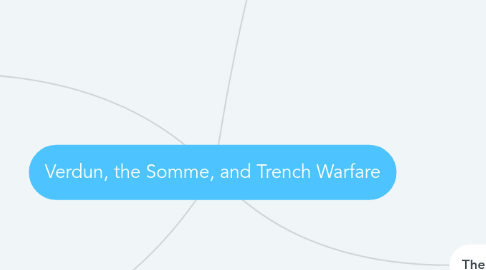
1. Trench Warfare
1.1. Germans fired 2 million shells in the opening eight hour bombardment. Tens of millions were fired over the course of Verdun
2. Falkenhayn and Verdun
2.1. Falkenhayn's choice of Verdun as the focus of the German offensive was shrewd
2.2. was convinced by 1916 that the war could only be won on the Western Front. Britain was Germany’s most formidable military foe, but remained out of reach across the Channel. He needed to weaken the French first.
2.3. planned to use a relatively small number of men to capture the high ground to the north of Verdun and then to inflict enormous casualties on the French using his superior German artillery to halt their counter-attacks.
2.4. Falkenhayn hoped to combine the Verdun offensive with a U-Boat offensive against British shipping. The two campaigns together should have brought France and Britain to terms.
2.4.1. But Falkenhayn's plan for an attack that would economise on German resources failed to work out as he had expected. He used many more divisions than planned. Germany accumulated huge losses and gained little territory, leading it to throw more and more men into the conflict: Verdun soon became a battle of prestige for the Germans, as well as the French.
2.5. notoriously secretive and shared very little with his staff about his strategy or aims for the battle.
2.6. His plan was to subject Verdun to intense bombardment, which would draw in and divert French troops from all over the Western Front to the eight mile wide front around Verdun
3. Battle of Verdun
3.1. In the letter Falkenhayn argued that the key to winning the way relied on the Western Front. This is because France could be defeated in a major set-piece battle Britain would in all likelihood seek terms with Germany or else be defeated
3.2. 1916
3.3. German Chief of Staff Erich von Falkenhayn sent a letter to Kaiser Wilhelm on Christmas Day 1915
3.3.1. In the letter Falkenhayn believed that Britain formed the foundation of the Allied effort ranged against Germany and that she must be removed from the war.
3.3.2. Falkenhayn's choice of Verdun as the focus of the German offensive was shrewd. Although relegated by France to the status of a minor fortress during the early stages of the war, France having lost faith in the value of fortress defenses, Verdun maintained a great psychological hold in the minds of the French people. On a practical level the woods immediately behind Verdun would have proved far easier to defend than the Verdun forts.s
3.3.3. Kaiser acted upon Falkenhayn's recommendations, agreeing to the policy of unrestricted submarine warfare, dangerous as it was in running the risk of bringing the US into the war. He also sanctioned implementation of a set-piece siege against Verdun, Falkenhayn's choice of French Target, starting in Feb 1916
3.4. Longest Battle,
3.4.1. lasted 300 days
3.4.2. 800,00 dead, wounded or missing
3.5. France won
3.5.1. but no side really had much to show in military gains
3.6. General Falkenhayn was notoriously secretive and shared very little with his staff about his strategy or aims for the battle.
3.6.1. As a result, German commanders had different objectives, ranging from capturing the town of Verdun to destroying the French army. Without a clear strategy, there was confusion about how to conduct the offensive.
3.6.1.1. division within the top ranks of the German army became apparent. Some commanders, such as the Kaiser's son, Crown Prince Wilhelm, wanted attacks to cease, while others encouraged Falkenhayn to reapply pressure. Falkenhayn eventually halted the offensive in July.
4. The Somme
4.1. July 1, 1916
4.2. The main Allied attack on the Western Front during 1916
4.3. Famous for the loss of 58,000 British troops
4.4. One of the bloodiest battles of WWI
4.5. The offensive was planned late in 1915 and was intended as a joint French-British attack
4.5.1. The French Commander in Chief, Joffre, thought of the idea as a battle of attrition, the goal was to drain the German forces of reserves, although territorial gain was a secondary aim
4.5.2. Although in reality British forces were collected by far the bulk of the offensive forces, Joffre and Haig originally intended for the attack to be a predominantly French offensive
4.5.3. The plan was approved by the new British Commander in Chief, Sir Douglas Haig, although Haig preferred an offensive among the open grounds of Flanders

